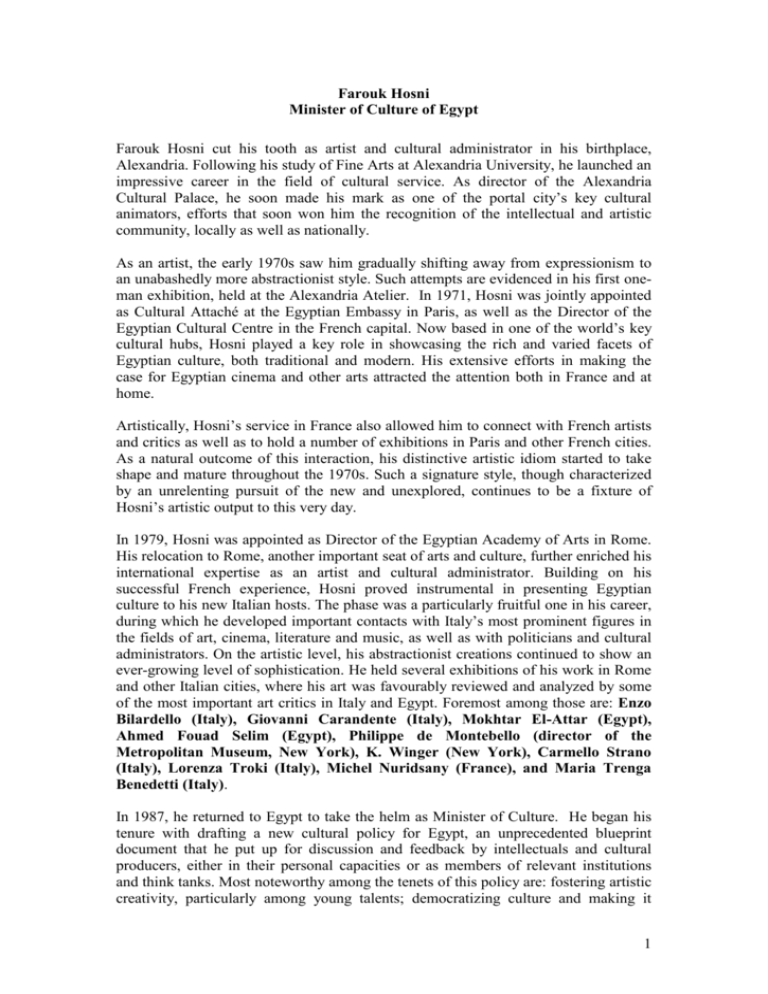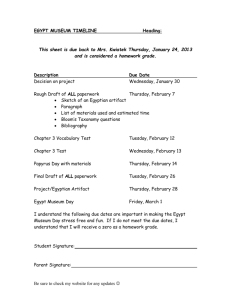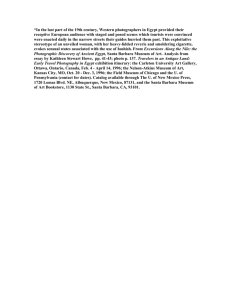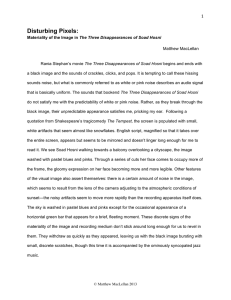C.V of Minister of Culture, Farouk Hosni
advertisement

Farouk Hosni Minister of Culture of Egypt Farouk Hosni cut his tooth as artist and cultural administrator in his birthplace, Alexandria. Following his study of Fine Arts at Alexandria University, he launched an impressive career in the field of cultural service. As director of the Alexandria Cultural Palace, he soon made his mark as one of the portal city’s key cultural animators, efforts that soon won him the recognition of the intellectual and artistic community, locally as well as nationally. As an artist, the early 1970s saw him gradually shifting away from expressionism to an unabashedly more abstractionist style. Such attempts are evidenced in his first oneman exhibition, held at the Alexandria Atelier. In 1971, Hosni was jointly appointed as Cultural Attaché at the Egyptian Embassy in Paris, as well as the Director of the Egyptian Cultural Centre in the French capital. Now based in one of the world’s key cultural hubs, Hosni played a key role in showcasing the rich and varied facets of Egyptian culture, both traditional and modern. His extensive efforts in making the case for Egyptian cinema and other arts attracted the attention both in France and at home. Artistically, Hosni’s service in France also allowed him to connect with French artists and critics as well as to hold a number of exhibitions in Paris and other French cities. As a natural outcome of this interaction, his distinctive artistic idiom started to take shape and mature throughout the 1970s. Such a signature style, though characterized by an unrelenting pursuit of the new and unexplored, continues to be a fixture of Hosni’s artistic output to this very day. In 1979, Hosni was appointed as Director of the Egyptian Academy of Arts in Rome. His relocation to Rome, another important seat of arts and culture, further enriched his international expertise as an artist and cultural administrator. Building on his successful French experience, Hosni proved instrumental in presenting Egyptian culture to his new Italian hosts. The phase was a particularly fruitful one in his career, during which he developed important contacts with Italy’s most prominent figures in the fields of art, cinema, literature and music, as well as with politicians and cultural administrators. On the artistic level, his abstractionist creations continued to show an ever-growing level of sophistication. He held several exhibitions of his work in Rome and other Italian cities, where his art was favourably reviewed and analyzed by some of the most important art critics in Italy and Egypt. Foremost among those are: Enzo Bilardello (Italy), Giovanni Carandente (Italy), Mokhtar El-Attar (Egypt), Ahmed Fouad Selim (Egypt), Philippe de Montebello (director of the Metropolitan Museum, New York), K. Winger (New York), Carmello Strano (Italy), Lorenza Troki (Italy), Michel Nuridsany (France), and Maria Trenga Benedetti (Italy). In 1987, he returned to Egypt to take the helm as Minister of Culture. He began his tenure with drafting a new cultural policy for Egypt, an unprecedented blueprint document that he put up for discussion and feedback by intellectuals and cultural producers, either in their personal capacities or as members of relevant institutions and think tanks. Most noteworthy among the tenets of this policy are: fostering artistic creativity, particularly among young talents; democratizing culture and making it 1 more accessible to a wider public; encouraging cultural openness to the rest of the world; completing the infrastructure of culture; and building new cultural institutions and outlets. Under his leadership, the Ministry of Culture underwent an important era of restructuring and expanding. Thus, Hosni founded or completely revamped some of the Ministry’s key institutions and sectors to cope with the ever-growing cultural and artistic arena resulting from his vision. Most noteworthy among these additions and developed institutions are: - The National Cultural Centre (popularly known as the Opera House) Dar –El-Kutub (The National Library and Archive) The General Organization of Cultural Palaces The Cultural Production Department The Cultural Development Fund The Foreign Cultural Relations Department The Fine Arts Department The Supreme Council of Antiquities The National Organization of Civic Scape Educational Contributions: As Minister of Culture, Hosni was keen to establish modern educational buildings equipped with state-of-the-art facilities and services; he subsequently added some of those buildings to the Academy of Arts. He also oversaw the process of modernizing the curricula and instructional methods used in the Academy’s institutes. He also paid great attention to the integration between modern technology and cultural work. Furthermore, he oversaw the founding of a number of new institutes, all affiliated with the Academy of Arts. These are: the Higher Institute of Child Arts, Institute of Environmental Architecture and the Institute of Conservation and Restoration Arts. He also founded a number of specialized laboratories, focusing on the conservation and restoration of historical documents, rare books and manuscripts – the first of such laboratories in the Middle East. He continues to encourage the training of new cadres of specialists in this important but rare field. He is credited with the idea of establishing specialized centres of creativity in the fields of poetry, criticism, theatre, cinema, children culture, and fine arts. These centres are now to be found throughout the whole of Egypt, particularly in the provinces. He also developed and modernized the infrastructure of many cultural institutions. Thanks to his vision, some of the key historical buildings in Cairo have now been transformed into cultural and research centres. Contributions in Library Building: He established a number of major libraries such as The Library of Greater Cairo. He also initiated the project to revive and modernize Dar E-Kutub (The National Library and Archive), restoring and digitizing its key documents, books and manuscripts. 2 He built more than 100 cultural centers in the less privileged villages across the Egyptian provinces, as part of an ambitious project aiming to open 10 new libraries every year. Initiated a process to modernize visions and policies, with the aim of encouraging the arts and young talents. Established a number of international activities and festivals in cinema, theatre, literature and the arts, thus allowing Egypt to occupy a prominent place in the international cultural community. Built and maintained important cultural bridges between Egypt and the rest of world, particularly Arab, European, Mediterranean, African and Asian countries. Contributions in Translation and Intercultural Interaction: Under his guidance, the Ministry established the National Project for Translation, which undertakes the translation of thousands of books to and from Arabic and across 27 world languages. Given his dedication to his mission, Hosni was a key defender of the freedom of expression, valiantly defending it against forces of obscurantism and reactionism. Thanks to him that Cairo established its Annual International Festival for Experimental Theatre; the first of its kind in the whole world. The festival continues to enjoy success and recognition across many parts of the world. Contributions in the Field of Museums: He embarked on an unprecedented activity in the field of museums. He founded 18 local and specialized museums, most significant among which are: The Museum of Nubia, the Museum of Embalmment, the Textile Museum, the Museum of Islamic Ceramics and the Museum of Orientalists. Contributions in the Field of Grand-Scale Projects: His pioneering project was the conservation and restoration of ancient Egyptian civilization landmarks; as well as restoring and reconstructing the historical Islamic Cairo of Egypt. More than 90% of the latter project has been already achieved. He is credited with the idea of building the world’s largest museum: The Grand Egyptian Museum, as well as another museum for Egyptian Civilization in the old city of Al-Fustat, the largest of its kind for Egyptian civilization. He undertook the largest movement in the history of Egypt for the conservation and restoration of the Egyptian Pharaonic, Coptic, Islamic and Graeco-Roman artifacts and sites. Among the monuments restored in the process are: the dismantling, reconstruction, and restoration of the Amenhotep Hall in the Temple of Luxor, the Hanging Church, the Coptic Museum, and the Old Walls of Cairo, the renovation of the Cairo Citadel and Pyramids surrounding, the project of rescuing the sunken antiquities in Alexandria, the restoration of 11 churches and 7 monasteries and the old 3 mosques in Egypt’s various provinces. He also initiated a historic conservation and restoration project for the Sphinx, which spanned over 10 years. As a result, international media such as the French "Le Monde" and the Italian Corriera della Sierra nicknamed him “the Minister of the Sphinx”. Exhibitions: Farouk Hosni’s artistic works have been exhibited in some of the world’s most prominent museums, including: - The Metropolitan Museum, 1999/2000 Le Carrousel de Louvres, 1998 Le Vittoriano, Italy 2005 The National Museum of Vienna, 1999 The Vigor Museum for Arts in Tokyo, 1996. The UNESCO Gallery in Paris, 1994. The National Geographic Society Museum in Washington DC, 2005 His works were also exhibited in the following museums in the Arab World: The Sursock Museum in Lebanon, the National Museum in Bahrain and in other museums in Morocco, Qatar, Bahrain, Abu Dhabi, and Saudi Arabia. Other Honours: 1- Professor Emeritus at the University of Soka in Japan, which also awarded him its honorary doctorate in 1993. 2- Professor Emeritus at the Faculty of Fine Arts at the University of Alexandria in 1999. 3- Recipient of the Culture and Peace Award from the Soka Gakkai International University in Japan in 1993. 4- Recipient of the Mediterranean Award in the Arts in 2006. 4







